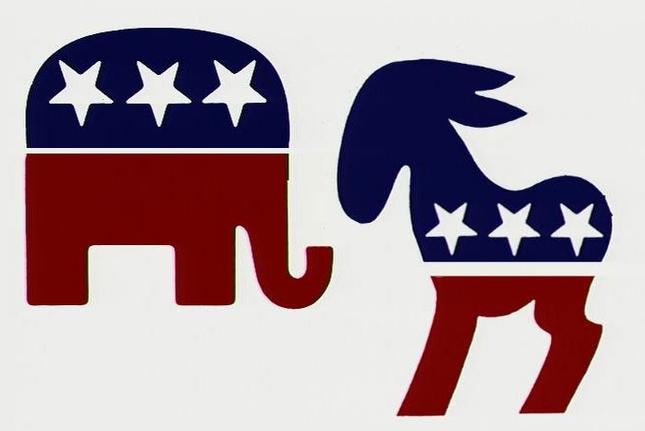Since Franklin Roosevelt was president, Republicans and Democrats have created diametrically opposite methods for choosing their presidential nominees.
Republicans pick a nominee with deep roots in the party, usually a man who previously lost an a run for the presidency. Democrats pick a nominee with virtually no name recognition, shallow roots and who is running for the presidency for the first time.
Republicans know whom they are going to nominate. They go through the motions, but they select one of their own, a proven commodity, a person who has been running since before the previous election. Democrats nominees are a surprise to their own party, to their own voters, to the public and to the Republicans.
Republicans don’t emerge. They run, lose, run again and win. It’s called paying dues. Democratic nominees seem to emerge out of nowhere and have to battle “no experience” charges which continue even if they are elected.
Before Franklin Roosevelt was elected in 1932, the parties’ conventions selected their nominees, so all candidates had deep roots and internal party allegiances. Roosevelt had been Secretary of the Navy and Governor of New York. Entering his fourth election for president, however, Roosevelt changed vice presidents and selected a former clothing store operator, a political pawn, a little known senator. Harry Truman became president a month into Roosevelt’s fourth term, having spent very little time with Roosevelt and was completely unaware that an atomic bomb – that he would order dropped a few months later – was being produced.
Since then, the parties have followed their unique paths to the presidency.
In 1948, the Republicans anointed New York Governor Thomas Dewey, a presumable shoo-in. He was so far ahead, the pollsters quit taking the public pulse in September. Truman prevailed.
In 1952, both parties knew World War II hero, Dwight Eisenhower, would win and begged him to join their party. (Remember both parties pursuing Colin Powell?) Eisenhower picked the Republicans and cruised into the White House. Richard Nixon was his vice president.
In 1960, Nixon moved into position as the Republican nominee. The Democrats selected the little known, little accomplished, junior, but wealthy, Senator John Kennedy. Kennedy defeated his Senate boss, the inside-the-party favorite, Lyndon Johnson. Nixon lost, but he won the nomination – and the presidency – in 1968.
In 1976, President Ford, the country’s only non-elected president, faced a challenge for the Republican nomination. Ronald Reagan was a famous movie star, TV commentator and a popular governor of California, the largest and typically Democratic state. Ford beat him but lost to Jimmy Carter.
Four years later in 1980, Reagan returned and defeated George H. W. Bush for the nomination. George H. W. Bush was a Texas Republican whose father had been a U.S. senator. Bush had been a congressman, had lost a run for the Senate, and had been U.S. Ambassador to China. Reagan picked Bush as his vice president and defeated the sitting President Carter.
In 1988, George H. W. Bush was Mr. Republican Establishment, won the nomination and the election against Massachusetts Governor Michael Dukakis. Again, Michael Who?
In 2000, the Republicans nominated Texas Governor George W. Bush, who had defeated a popular Democratic governor in 1994. Had his name been George Walker instead of George Walker Bush, he would never have gone to Yale or Harvard, been given an ownership interest and the CEO position of the Texas Rangers major league baseball team and never have run for office. His last name was Bush, and his dad had been President. George W. Bush didn’t have to lose to win, but how establishment can a candidate be?
Since Roosevelt, the Democrats have selected Jimmy Who?, Bill Who? and Barack Huh?
In 1976, Jimmy Carter, better known as Jimmy Who, was a little known, peanut farmer who had served one term as Georgia’s governor. No one on the national scene had ever heard of him. He had a 1-percent name recognition rating going into the Iowa caucuses and defeated a slew of established Democrats for the nomination.
In 1992, establishment Democrats were afraid to run against George H. W. Bush’s 91-percent approval rating. Bill Clinton, another small-state governor who had given an awful speech at the 1988 Democratic National Convention, took the plunge. Most Americans probably cannot find Arkansas on a map. He faced ongoing charges of immoral behavior during the election (and during his presidency).
In 2008, Hilary Clinton had the nomination locked up, but Barak Obama who had served as a U.S. senator for a mere four years, surprised her, the nation and is now president.
When Democrats nominate mainstream candidates, they lose. Vice Presidents Hubert Humphrey, Walter Mondale and Al Gore couldn’t get to the finish line.
What does this mean? The only Republicans running now who have a chance to win are Mitt Romney and Newt Gingrich. Romney ran in 2004 and lost. He’s ripe. Gingrich talks about being a Washington outsider, but he lives there and is trying to ride President Reagan’s coattails.
Rick Santorum is not and Jon Huntsman was not really running this year. They are running for the Republican nomination in 2016. Whom will they run against? Some Democrat who has a 1-percent name recognition right now.


